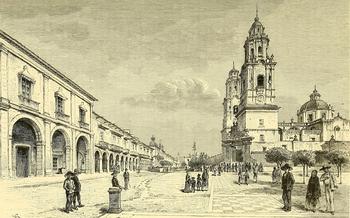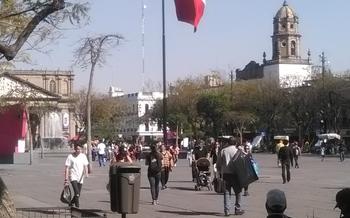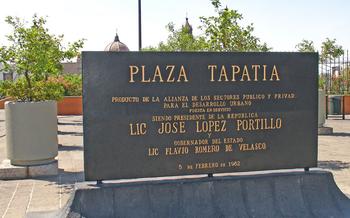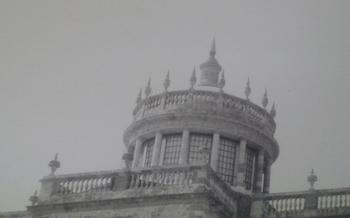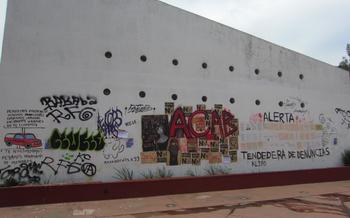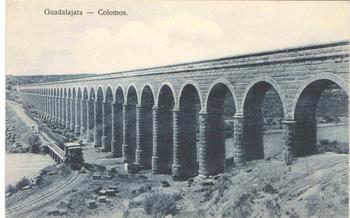
Hospicio Cabañas
- José Clemente Orozco Murals
- Architecture and Design
- Exhibitions and Galleries
- Guided Tours
- Self-Guided Exploration
- Photography and Videography
- Hours of Operation and Admission Fees:
- Accessibility
- Museum Shop and Café
- Location and Transportation
- Nearby Attractions: Exploring the Cultural Gems of Guadalajara
- Dress Code and Etiquette
- Accommodations and Dining:
- A Hidden Gem: The Secret Chapel
José Clemente Orozco Murals
The Hospicio Cabañas is renownedinspiring artworks cover the walls and ceilings of the building's interior, depicting powerful and poignant scenes that explore social, political, and historical themes. Orozco's murals are a testament to his artistic genius and his commitment to using art as a tool for social commentary.
The murals at the Hospicio Cabañas are divided into four main cycles: "The Conquest," "The Colony," "The Independence," and "The Revolution." Each cycle depicts key moments in Mexican history, from the arrival of the Spanish conquistadors to the Mexican Revolution. Orozco's murals are not merely historical records; they are also powerful indictments of colonialism, oppression, and social injustice.
Orozco's use of color, line, and composition is masterful. His murals are characterized by bold, vibrant colors, dynamic lines, and dramatic compositions that create a sense of movement and energy. Orozco's figures are often distorted and exaggerated, reflecting the tumultuous and often violent nature of Mexican history.
The murals at the Hospicio Cabañas are not just works of art; they are also powerful statements about Mexican identity and history. They have had a profound impact on Mexican art and culture, and they continue to inspire and challenge viewers to this day.
Architecture and Design
The Hospicio Cabañas' architectural design is a testament to the fusion of Baroque and Neoclassical styles, resulting in a visually stunning and harmonious ensemble. The building's layout is arranged around a central courtyard, which is surrounded by arcaded corridors on two levels. The use of local materials, such as tezontle volcanic rock, adds a unique character and warmth to the structure.
The Hospicio Cabañas' façade is adorned with intricate carvings and sculptures, which showcase the Baroque influence. The grand entrance features an impressive archway flanked by columns, leading visitors into the spacious courtyard. The arcaded corridors, supported by slender columns, create a sense of lightness and elegance, while the dome that crowns the building adds a majestic touch.
The interior of the Hospicio Cabañas is equally impressive, with its vaulted ceilings, grand staircases, and expansive hallways. The building's design reflects Enlightenment ideals of order and symmetry, with each space carefully planned to serve a specific purpose. The harmonious blend of Baroque and Neoclassical elements creates a captivating atmosphere that transports visitors back in time.
Exhibitions and Galleries
The Hospicio Cabañas is home to a diverse range of exhibitions and galleries that showcase the rich cultural heritage of Mexico. Visitors can explore a vast collection of paintings, sculptures, textiles, and historical documents that provide insights into the country's past and present. The museum's permanent collection includes works by renowned Mexican artists, such as José Clemente Orozco, Diego Rivera, and Frida Kahlo.
The Hospicio Cabañas also hosts temporary exhibitions that feature contemporary art, photography, and historical artifacts. These exhibitions provide a platform for emerging artists and explore various themes and issues relevant to Mexican society. Visitors can immerse themselves in the vibrant and diverse art scene of Mexico and gain a deeper understanding of the country's cultural identity.
In addition to the main galleries, the Hospicio Cabañas houses a specialized library and archive that contain a wealth of information on Mexican art and history. Researchers and scholars can access a vast collection of books, manuscripts, and documents that provide valuable insights into the country's cultural heritage. The museum's library and archive contribute to its role as a center for cultural research and education.
The Hospicio Cabañas' exhibitions and galleries offer a multi-sensory experience that allows visitors to connect with Mexican art and culture on a deeper level. Through its diverse collection and engaging exhibitions, the museum serves as a vibrant platform for cultural exchange and education, fostering a greater appreciation for the richness and diversity of Mexican artistic expression.
Guided Tours
Guided tours of the Hospicio Cabañas offer a deeper and more informative experience for visitors. Knowledgeable guides provide insights into the history, architecture, and artwork of the building, bringing its stories to life. Tours are available in various languages, including English and Spanish, to accommodate visitors from different countries.
Visitors can choose from different types of guided tours. General tours provide an overview of the Hospicio Cabañas, covering its history, architectural features, and most famous murals by José Clemente Orozco. Themed tours delve into specific aspects of the museum, such as the social and political themes depicted in Orozco's murals or the architectural influences that shaped the building's design. Specialized tours cater to specific groups, such as students or researchers, offering tailored content and insights.
To book a guided tour, visitors can contact the Hospicio Cabañas directly through their website or by phone. Reservations are recommended, especially for groups or during peak tourist seasons. The museum also offers audio guides for self-guided tours, providing a narrated commentary on the highlights of the collection.
Self-Guided Exploration
For those who prefer a more independent exploration of the Hospicio Cabañas, there are several tips to ensure a fulfilling visit. Firstly, plan a suggested itinerary to make the most of your time. Start with the main highlights, such as the José Clemente Orozco murals in the main courtyard, and then explore the other galleries and exhibitions at your own pace.
Secondly, take advantage of the audio guides and informational brochures available at the museum. These provide insightful commentary and historical context, enhancing the self-guided experience. Remember to respect the artwork and follow museum guidelines during your exploration. Avoid touching or leaning against the murals, and be mindful of other visitors.
Finally, consider booking a guided tour if you have specific interests or want to delve deeper into the history and significance of the Hospicio Cabañas. Guided tours offer expert insights and personalized attention, making them a valuable option for those seeking a more comprehensive understanding of the museum.
Photography and Videography
Photography and videography are permitted within the Hospicio Cabañas, allowing visitors to capture and share the beauty of the murals and other artworks. However, there are a few guidelines and restrictions to keep in mind.
The use of flash photography is prohibited, as it can damage the sensitive pigments and colors of the murals. Tripods are also not allowed, as they can obstruct the flow of visitors and pose a safety hazard.
To capture the best shots, consider the lighting conditions and angles. The natural light streaming through the courtyard and windows provides ample illumination for photography. Experiment with different perspectives to capture the grandeur of the murals and the intricate details of the architecture.
Before filming or recording any interviews or events within the museum, it is essential to obtain permission from the museum staff. This ensures that the filming does not disrupt other visitors or interfere with the museum's operations.
By following these guidelines, visitors can document their experience at the Hospicio Cabañas while respecting the artwork and the museum's environment.
Hours of Operation and Admission Fees:
The Hospicio Cabañas is open to the public from Tuesday to Sunday, with specific hours varying throughout the year. During the high season (November to April), the museum is open from 10:00 am to 5:00 pm, while during the low season (May to October), the hours are from 10:00 am to 4:00 pm. The museum is closed on Mondays and on certain holidays, such as Christmas Day and New Year's Day.
Admission fees for the Hospicio Cabañas vary depending on the visitor's status. General admission tickets for adults cost 150 pesos, while students, seniors, and children under 13 years old can enjoy a discounted rate of 75 pesos. Additionally, the museum offers free admission to visitors every Tuesday. It is advisable to purchase tickets in advance, either online or at the museum's ticket office, to avoid long queues during peak hours.
Accessibility
The Hospicio Cabañas is committed to providing an inclusive and accessible experience for all visitors, regardless of their abilities. Wheelchair ramps, elevators, and accessible restrooms are available throughout the museum, ensuring that visitors with disabilities can navigate the building with ease. The museum also offers guided tours in sign language and audio-described tours for visitors with visual impairments. To ensure a smooth and enjoyable visit, visitors with disabilities are encouraged to contact the museum staff in advance to arrange for any specific accessibility needs or accommodations.
Museum Shop and Café
The Hospicio Cabañas also houses a well-stocked museum shop where visitors can purchase a variety of souvenirs and merchandise related to the museum and its collection. The shop offers a wide range of items, including books, prints, postcards, and handicrafts, all of which are carefully curated to reflect the museum's unique history and artistic significance.
By purchasing items from the museum shop, visitors not only take home a tangible reminder of their visit but also contribute to the maintenance and preservation of the Hospicio Cabañas. The proceeds from the shop directly support the museum's ongoing operations, ensuring that future generations can continue to enjoy and appreciate this extraordinary cultural institution.
In addition to the museum shop, the Hospicio Cabañas also features a charming café located within the museum grounds. The café offers a selection of light refreshments and snacks, providing visitors with a place to relax and refuel after exploring the museum's many exhibits and galleries.
Whether you're looking for a unique souvenir or a quick bite to eat, the Hospicio Cabañas' museum shop and café are worth checking out. Your purchases not only support the museum but also contribute to the vibrant cultural scene of Guadalajara.
Location and Transportation
The Hospicio Cabañas is conveniently located in the heart of Guadalajara, making it easily accessible by various transportation options. Situated at Cabañas 8, Plaza Liberación, in the Centro Histórico neighborhood, the museum is surrounded by historical landmarks, cultural venues, and vibrant streets.
To reach the Hospicio Cabañas, visitors can utilize Guadalajara's efficient public transportation system. Several bus routes stop within walking distance of the museum, connecting it to different parts of the city. Taxis and ride-sharing apps are also readily available, offering a convenient and comfortable mode of transportation.
For those driving, there are several parking facilities near the museum. The nearest option is the Estacionamiento Hospicio Cabañas, located just a short walk away. Visitors can also find street parking in the surrounding area, although it may be limited during peak hours.
Navigating the area around the Hospicio Cabañas is easy and enjoyable. The museum is situated within the pedestrian-friendly Centro Histórico district, allowing visitors to explore the neighborhood on foot. Several notable attractions, restaurants, and shops are just a short stroll away, making it easy to combine a visit to the museum with other activities.
Nearby Attractions: Exploring the Cultural Gems of Guadalajara
Adjacent to the Hospicio Cabañas lies an array of captivating attractions that further enrich the cultural tapestry of Guadalajara. Within easy walking distance, visitors can immerse themselves in the Museo Regional de Guadalajara, showcasing an impressive collection of pre-Columbian artifacts and colonial art. The Teatro Degollado, a majestic neoclassical theater, invites visitors to experience Guadalajara's vibrant performing arts scene.
A short stroll away, the Instituto Cultural Cabañas offers a diverse range of exhibitions and cultural events, from contemporary art installations to traditional Mexican dance performances. The Museo de las Artes de la Universidad de Guadalajara boasts an eclectic collection of modern and contemporary art from both local and international artists.
For those seeking a tranquil escape, the Jardín del Santuario offers a serene oasis amidst the urban bustle, complete with a charming fountain and lush greenery. To delve deeper into Guadalajara's culinary heritage, visitors can explore the Mercado Libertad, a bustling market brimming with authentic Mexican flavors and local delicacies.
Planning a day or weekend trip around the Hospicio Cabañas and these nearby attractions allows visitors to fully immerse themselves in the cultural riches of Guadalajara. Whether you're an art enthusiast, history buff, or simply seeking unique experiences, this vibrant neighborhood offers something for every traveler.
Dress Code and Etiquette
Visitors to the Hospicio Cabañas are expected to dress respectfully and behave appropriately, considering the museum's cultural and historical significance. Casual attire is generally acceptable, but it is important to avoid wearing anything too revealing or disruptive. Shorts, tank tops, and flip-flops are not recommended.
Respect for the artworks and the museum environment is paramount. Visitors should avoid touching or leaning on the murals and other exhibits. Flash photography and tripods are not permitted, as they can damage the artwork. Eating and drinking are not allowed inside the museum, except in designated areas.
Be mindful of noise levels and avoid talking loudly or using electronic devices that may disturb other visitors. It is important to maintain a quiet and respectful atmosphere within the museum.
By following these simple guidelines, visitors can help preserve the Hospicio Cabañas as a welcoming and enjoyable space for all. Remember, behaving respectfully not only enhances your own experience but also contributes to the overall enjoyment of all visitors.
Accommodations and Dining:
When it comes to accommodations, the area surrounding the Hospicio Cabañas offers a range of options to suit every budget and preference. From budget-friendly hostels that cater to backpackers and solo travelers to luxurious hotels that provide a more upscale experience, there's something for everyone.
For dining, the surrounding neighborhood is a culinary paradise, offering a diverse array of restaurants to satisfy every palate. Traditional Mexican cuisine is a must-try, with local specialties such as tortas ahogadas, birria, and pozole. International cuisine is also well-represented, with restaurants serving everything from Italian to Japanese and everything in between.
To truly immerse yourself in the local culinary scene, don't miss the opportunity to visit the Mercado Libertad, a vibrant market located just a short walk from the Hospicio Cabañas. Here, you'll find an array of fresh produce, traditional Mexican dishes, and local delicacies.
For those looking for a more upscale dining experience, the nearby Plaza de la Liberación offers a variety of fine-dining restaurants with stunning views of the city. No matter your budget or preferences, you're sure to find something to your liking in the culinary landscape surrounding the Hospicio Cabañas.
A Hidden Gem: The Secret Chapel
Beyond the grand murals and architectural wonders, the Hospicio Cabañas hides a secret gem that few visitors know about: the hidden chapel. Tucked away in a secluded corner of the museum, this intimate space was once a place of worship for the orphans and residents of the hospice. Today, it remains a sacred and serene sanctuary, adorned with beautiful stained-glass windows and intricate religious artwork.
While the chapel is not always open to the public, visitors who inquire at the museum's front desk may be granted access if it is not in use for a private event. The chapel offers a unique glimpse into the spiritual life of the Hospicio Cabañas and is a must-see for those seeking a deeper connection with the history and culture of this remarkable institution.
